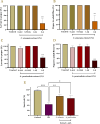Dual effects of Camellia sinensis and Andrographis paniculata on hyperglycemia and infection in Drosophila
- PMID: 40352246
- PMCID: PMC12059832
- DOI: 10.52225/narra.v5i1.1972
Dual effects of Camellia sinensis and Andrographis paniculata on hyperglycemia and infection in Drosophila
Abstract
The coexistence of hyperglycemia and infectious diseases represents a critical global health challenge, particularly in resource-limited settings where it amplifies disease severity and complicates treatment approaches. Medicinal plants such as Camellia sinensis and Andrographis paniculata have gained recognition for their antioxidant, anti-inflammatory, and antimicrobial properties, making them promising candidates for addressing this double health burden. The aim of this study was to establish a preclinical model of hyperglycemia and infection (HI model) using Drosophila melanogaster and to investigate the therapeutic potential of C. sinensis and A. paniculata extracts in alleviating the burden associated with the HI condition. In this study, the HI model was established by simultaneously exposing D. melanogaster larvae to a high-concentration sucrose solution and Staphylococcus aureus for 24 hours. The larvae were then transferred to a high-sucrose diet supplemented with C. sinensis or A. paniculata extracts. Survival assays and molecular analyses were subsequently performed to evaluate the outcomes. Our findings revealed that the combination of hyperglycemia and infection significantly reduced survival rates in the Drosophila model. However, treatment with 1.25% C. sinensis and A. paniculata extracts notably improved survival, attributed to their antibacterial activity and regulation of key molecular pathways involved in immune responses, metabolic balance, and endogenous antioxidant defenses. These findings validate the utility of D. melanogaster as a model organism for investigating the double burden of HI. Furthermore, the study offers compelling evidence of the dual therapeutic potential of C. sinensis and A. paniculata in mitigating the detrimental effects of this condition. Overall, this research underscores the significant promise of plant-derived compounds in managing HI and paves the way for future studies to explore their underlying mechanisms and potential clinical applications.
Keywords: Andrographis paniculata; Camellia sinensis; Drosophila; hyperglycemia; infection.
© 2025 The Author(s).
Conflict of interest statement
All the authors declare that there are no conflicts of interest.
Figures






Similar articles
-
Phytochemical analysis of Andrographis paniculata and Orthosiphon stamineus leaf extracts for their antibacterial and antioxidant potential.Trop Biomed. 2013 Sep;30(3):467-80. Trop Biomed. 2013. PMID: 24189677
-
Antibacterial Activity of Silver Nanoparticles Prepared from Camellia Sinensis Extracts in Multi-Drug Resistant Staphylococcus Aureus.Cell Physiol Biochem. 2024 Nov 11;58(6):659-676. doi: 10.33594/000000741. Cell Physiol Biochem. 2024. PMID: 39535105
-
Inhibitory effect of some herbal extracts on adherence of Streptococcus mutans.J Ethnopharmacol. 2004 Jun;92(2-3):281-9. doi: 10.1016/j.jep.2004.03.008. J Ethnopharmacol. 2004. PMID: 15138013
-
Andrographis paniculata (Burm.f.) Nees: Traditional uses, phytochemistry, pharmacological properties and quality control/quality assurance.J Ethnopharmacol. 2021 Jul 15;275:114054. doi: 10.1016/j.jep.2021.114054. Epub 2021 Apr 6. J Ethnopharmacol. 2021. PMID: 33831465 Review.
-
Andrographis paniculata Dosage Forms and Advances in Nanoparticulate Delivery Systems: An Overview.Molecules. 2022 Sep 20;27(19):6164. doi: 10.3390/molecules27196164. Molecules. 2022. PMID: 36234698 Free PMC article. Review.
References
-
- ElSayed NA, Aleppo G, Aroda VR, et al. . 2. Classification and diagnosis of diabetes: Standards of care in diabetes-2023. Diabetes Care 2023;46(Suppl 1):S19–S40. - PubMed
-
- Jafar N, Edriss H, Nugent K. The effect of short-term hyperglycemia on the innate immune system. Am J Med Sci 2016;351(2):201–211. - PubMed
MeSH terms
Substances
LinkOut - more resources
Full Text Sources
Medical
Molecular Biology Databases
